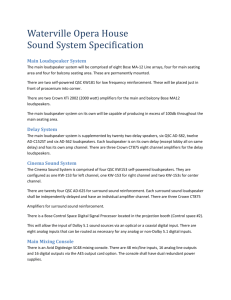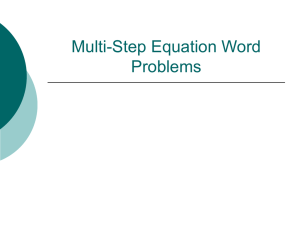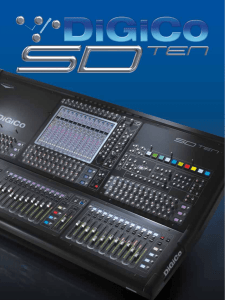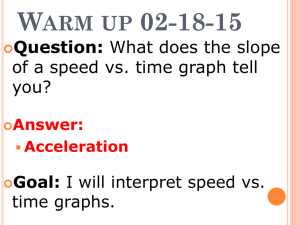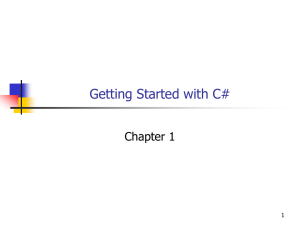Sound Reinforcement Presentation
advertisement
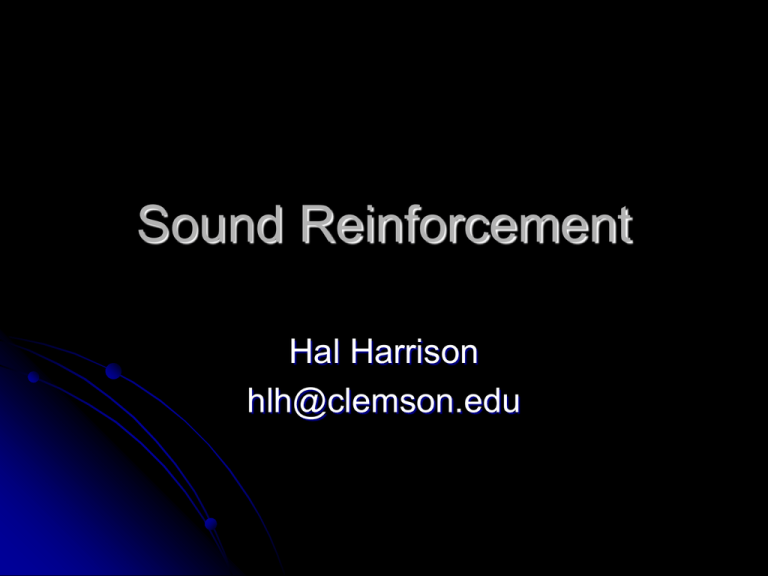
Sound Reinforcement Hal Harrison hlh@clemson.edu What is a Sound System? A sound REINFORCEMENT system, not a sound system. Reasons for having a reinforcement system: Help people hear something better. To make sound louder for artistic reasons. To enable people to hear sound in remote locations. Conceptual Model of a Sound System Sound Waves and Propagation What we hear as sound is a class of kinetic energy called acoustical energy. Acoustical energy consists of fluctuating waves of pressure in air. Waves have peaks and valleys. The start and end of a wave (either peak to peak or valley to valley) is known as a cycle. To be classified as sound, waves must fluctuate at a rate between 20 and 20,000 cycles per second (cps). The amount of cycles waves fluctuate per second is known as frequency. Hertz (Hz) is used to indicate frequency in cycles per second. 20 Hz = 20 cps Generally speaking, the higher the frequency, the higher the perceived pitch of a sound. Representation of a Sound Wave The Electrical Representation of Sound An audio signal is an electrical representation of sound. In analog audio electronics, the signal voltage fluctuates the same way as the acoustical energy it represents. The amplitude (or strength) of an audio signal is called the signal level. Sound level is specified in decibels (dB). Input Transducers Air pressure or velocity microphones Contact pickups Magnetic pickup cassette tapes Phonograph pickups electric stringed instruments Tape heads acoustic guitar, mandolin, violin record players Laser pickups CD, MD Output Transducers Woofer loudspeakers Midrange loudspeakers mid-range frequency reproduction 500Hz-4kHz range Tweeter loudspeakers low frequency reproduction >500Hz high frequency reproduction <4kHz Full-range loudspeakers Integration of 2 or more of the other loudspeaker systems. Output Transducers continued Subwoofer loudspeakers extended low frequency 30Hz-150Hz range Monitor (foldback) loudspeakers full range loudspeakers designed for the performer on stage to hear themselves. Headphones Practical Model of a Sound System Frequency Response The Frequency Response (FR) of a device describes the relationship between the device’s input and output with regard to signal frequency and amplitude. FR and Acoustical Factors The FR of any sound system is affected by the environment in which it works. Outdoor factors: wind – deflects sound as it travels temperature – deflects sound as it travels air absorption – sound (higher frequencies) are absorbed over distance Indoor factors: room reflections – walls, ceilings, floor surfaces room resonances The Decibel Decibel (dB) Decibels describe a ratio of two quantities often related to power. PROBLEM: What is the ratio, in dB of 2 watts to 1 watt? dB = 10 log (P1 / P0) = 10 log ( 2 / 1) = 10 log 2 = 10 X .301 = 3.01 or 3dB WHICH MEANS - Whenever one power is twice another, it is 3dB greater! Relating the Decibel to Acoustic Levels Volume, Level, and Gain Volume – defined as a power level in audio, it means turn up the volume! bad term as it relates to a cubic dimension. Level – magnitude of a quantity in relation to a arbitrary reference value. Sound Pressure Level (SPL) Gain – assume to be transmission gain, which is the power increase of a signal expressed in dB. Dynamic Range and Headroom Dynamic Range - the difference in dB between the loudest and the quietest portion of a program. Headroom – the difference between the normal operating level and the highest (peak) level of program material. Headroom Illustration Break Time! Balanced Cables Used to connect line level and mic level sources such as microphones (XLR) and input/output connections (console to amp) Unbalanced Cables Used to connect line-level signals such as guitars, keyboards, bass, etc. (1/4”) Insert Cables Used to connect channel or group specific devices such as: Compressors Limiters Gates Microphones: Selection Dynamic (3.1) Condenser (3.2) Phantom power +48v needed for operation Microphones: Pickup Pattern A pick-up pattern refers to the area(s) from which a microphone “picks up” its sound. Types: Omni (3.3) Cardioid (3.4) Super-cardioid (3.5) Typical Console Signal Flow Mono Input A – XLR microphone level input B – ¼” line level input balanced/unbalanced C – ¼” line level insert (1.1) balanced Inserts are both sends and returns Unbalanced D – ¼” line level direct output balanced/unbalanced Mono Input E – Gain / trim control F – High Pass Filter (HPF) aka Low-cut filter G – Equalization section Mono Input H – Auxiliary send section I – Pan control J – Pre-Fade Listen (PFL) switch K – Channel “On” switch aka mute button L - Fader M – Assignment switch aka routing button Subgroups Allow logical assignment of groups of instruments or vocalists so that they may be controlled by just one pair of faders, or even a single fader. Console Master Section N – line level master outputs (¼” or XLR) O – line level control room/monitor output P – line level 2-track tape return (RCA) S – meters U – 48v global Phantom power switch V – headphone output (1/4”) headphone level Console Master Section Q – auxiliary send master section R – After-fade listen (AFL) Typical Console Input/Output Setup Input Gain Input gain controls are designed to take a signal and adjust it till it is usable by the mixing console. Setting Gain Structure 1. 2. 3. 4. Press the PFL/Solo switch on the relevant input. Adjust gain/input sensitivity until meters read within the yellow (‘3’ to ‘6’ on meter scale). This allows for the extra 10dB of gain that is available on Soundcraft input faders. Release PFL/Solo. Repeat for all other inputs. Faders Faders allow for fine adjustments to your inputs. Normal operating levels for faders should be at “0” or unity. Faders are logarithmic. Equalization Used to make corrective and creative sound changes. BASIC RULE OF EQ: Console EQ types: If it sounds good, it is good! fixed band, semi-parametric, fully parametric Center position has no effect on sound. Counterclockwise – decrease in EQ frequency level. Clockwise – increase in EQ frequency level. Fixed Equalization Same as treble/bass controls on home stereo systems. Semi-parametric Equalization Similar to fixed EQ, but has more control as the midrange EQ is usually sweepable. Sweep – console EQ knob which is selectable between a range of frequencies. Removing Unwanted Sound with EQ 1. 2. 3. 4. Increase sweep-EQ gain. Sweep the frequency pot until the aspect of the sound you wish to modify becomes as pronounced as possible. This should only take a few seconds. The cut/boost control is now changed from its full boost position to cut. The exact amount of cut required can be decided by listening to the sound while making adjustments. Even a small amount of cut at the right frequency will clean up the sound to a surprising degree. Other sounds may benefit from a little boost, one example being the electric guitar which often needs a little extra bite to help it cut through the mix. Again, turn to full boost and use the frequency control to pick out the area where the sound needs help. Then it’s a simple matter of turning the boost down to a more modest level and assessing the results by ear. Caution: when adjusting EQ, there is a danger of feedback which can cause damage to your speakers. You may need to reduce your levels to compensate. Fully Parametric Equalization Similar to a semi-parametric EQ, but has more control. Fully parametric EQs have sweeps on all bands of EQ and most have bandwidth control as well. Bandwidth aka (Q) – the broadness or the steepness of a frequency curve. The higher the bandwidth, the steeper the curve. Fully Parametric Equalization Curve Auxiliary Sends Two types: Pre-fade auxes – monitors Post-fade auxes – reverbs, delays, recording feeds, etc Pre-fade auxiliaries are independent of the fader so that the amount of effect will not change with new fader levels. This means you will still hear the effect even when the fader is at the bottom of its travel It is important to use post fade auxiliary sends for effects units. This is because post fade auxiliaries ‘follow’ the input fader so that when input level changes the amount of effect remains proportional to the new input level. Gates A gate is designed to shut down the audio signal path when the input signal falls below a threshold set by the user. It may be used to clean-up any signal that has pauses in it. Compressors A compressor reduces the difference between the loudest and quietest parts of a performance. It works on a threshold system where signals exceeding the threshold are processed and those falling below it pass through unchanged. When a signal exceeds the threshold the compressor automatically reduces the gain.



